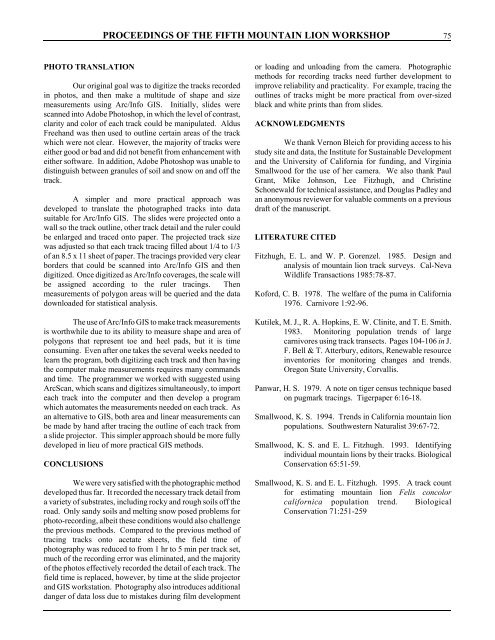Proceedings of the fifth mountain lion workshop: 27
Proceedings of the fifth mountain lion workshop: 27
Proceedings of the fifth mountain lion workshop: 27
Create successful ePaper yourself
Turn your PDF publications into a flip-book with our unique Google optimized e-Paper software.
PHOTO TRANSLATION<br />
PROCEEDINGS OF THE FIFTH MOUNTAIN LION WORKSHOP 75<br />
Our original goal was to digitize <strong>the</strong> tracks recorded<br />
in photos, and <strong>the</strong>n make a multitude <strong>of</strong> shape and size<br />
measurements using Arc/Info GIS. Initially, slides were<br />
scanned into Adobe Photoshop, in which <strong>the</strong> level <strong>of</strong> contrast,<br />
clarity and color <strong>of</strong> each track could be manipulated. Aldus<br />
Freehand was <strong>the</strong>n used to outline certain areas <strong>of</strong> <strong>the</strong> track<br />
which were not clear. However, <strong>the</strong> majority <strong>of</strong> tracks were<br />
ei<strong>the</strong>r good or bad and did not benefit from enhancement with<br />
ei<strong>the</strong>r s<strong>of</strong>tware. In addition, Adobe Photoshop was unable to<br />
distinguish between granules <strong>of</strong> soil and snow on and <strong>of</strong>f <strong>the</strong><br />
track.<br />
A simpler and more practical approach was<br />
developed to translate <strong>the</strong> photographed tracks into data<br />
suitable for Arc/Info GIS. The slides were projected onto a<br />
wall so <strong>the</strong> track outline, o<strong>the</strong>r track detail and <strong>the</strong> ruler could<br />
be enlarged and traced onto paper. The projected track size<br />
was adjusted so that each track tracing filled about 1/4 to 1/3<br />
<strong>of</strong> an 8.5 x 11 sheet <strong>of</strong> paper. The tracings provided very clear<br />
borders that could be scanned into Arc/Info GIS and <strong>the</strong>n<br />
digitized. Once digitized as Arc/Info coverages, <strong>the</strong> scale will<br />
be assigned according to <strong>the</strong> ruler tracings. Then<br />
measurements <strong>of</strong> polygon areas will be queried and <strong>the</strong> data<br />
downloaded for statistical analysis.<br />
The use <strong>of</strong> Arc/Info GIS to make track measurements<br />
is worthwhile due to its ability to measure shape and area <strong>of</strong><br />
polygons that represent toe and heel pads, but it is time<br />
consuming. Even after one takes <strong>the</strong> several weeks needed to<br />
learn <strong>the</strong> program, both digitizing each track and <strong>the</strong>n having<br />
<strong>the</strong> computer make measurements requires many commands<br />
and time. The programmer we worked with suggested using<br />
ArcScan, which scans and digitizes simultaneously, to import<br />
each track into <strong>the</strong> computer and <strong>the</strong>n develop a program<br />
which automates <strong>the</strong> measurements needed on each track. As<br />
an alternative to GIS, both area and linear measurements can<br />
be made by hand after tracing <strong>the</strong> outline <strong>of</strong> each track from<br />
a slide projector. This simpler approach should be more fully<br />
developed in lieu <strong>of</strong> more practical GIS methods.<br />
CONCLUSIONS<br />
We were very satisfied with <strong>the</strong> photographic method<br />
developed thus far. It recorded <strong>the</strong> necessary track detail from<br />
a variety <strong>of</strong> substrates, including rocky and rough soils <strong>of</strong>f <strong>the</strong><br />
road. Only sandy soils and melting snow posed problems for<br />
photo-recording, albeit <strong>the</strong>se conditions would also challenge<br />
<strong>the</strong> previous methods. Compared to <strong>the</strong> previous method <strong>of</strong><br />
tracing tracks onto acetate sheets, <strong>the</strong> field time <strong>of</strong><br />
photography was reduced to from 1 hr to 5 min per track set,<br />
much <strong>of</strong> <strong>the</strong> recording error was eliminated, and <strong>the</strong> majority<br />
<strong>of</strong> <strong>the</strong> photos effectively recorded <strong>the</strong> detail <strong>of</strong> each track. The<br />
field time is replaced, however, by time at <strong>the</strong> slide projector<br />
and GIS workstation. Photography also introduces additional<br />
danger <strong>of</strong> data loss due to mistakes during film development<br />
or loading and unloading from <strong>the</strong> camera. Photographic<br />
methods for recording tracks need fur<strong>the</strong>r development to<br />
improve reliability and practicality. For example, tracing <strong>the</strong><br />
outlines <strong>of</strong> tracks might be more practical from over-sized<br />
black and white prints than from slides.<br />
ACKNOWLEDGMENTS<br />
We thank Vernon Bleich for providing access to his<br />
study site and data, <strong>the</strong> Institute for Sustainable Development<br />
and <strong>the</strong> University <strong>of</strong> California for funding, and Virginia<br />
Smallwood for <strong>the</strong> use <strong>of</strong> her camera. We also thank Paul<br />
Grant, Mike Johnson, Lee Fitzhugh, and Christine<br />
Schonewald for technical assistance, and Douglas Padley and<br />
an anonymous reviewer for valuable comments on a previous<br />
draft <strong>of</strong> <strong>the</strong> manuscript.<br />
LITERATURE CITED<br />
Fitzhugh, E. L. and W. P. Gorenzel. 1985. Design and<br />
analysis <strong>of</strong> <strong>mountain</strong> <strong>lion</strong> track surveys. Cal-Neva<br />
Wildlife Transactions 1985:78-87.<br />
K<strong>of</strong>ord, C. B. 1978. The welfare <strong>of</strong> <strong>the</strong> puma in California<br />
1976. Carnivore 1:92-96.<br />
Kutilek, M. J., R. A. Hopkins, E. W. Clinite, and T. E. Smith.<br />
1983. Monitoring population trends <strong>of</strong> large<br />
carnivores using track transects. Pages 104-106 in J.<br />
F. Bell & T. Atterbury, editors, Renewable resource<br />
inventories for monitoring changes and trends.<br />
Oregon State University, Corvallis.<br />
Panwar, H. S. 1979. A note on tiger census technique based<br />
on pugmark tracings. Tigerpaper 6:16-18.<br />
Smallwood, K. S. 1994. Trends in California <strong>mountain</strong> <strong>lion</strong><br />
populations. Southwestern Naturalist 39:67-72.<br />
Smallwood, K. S. and E. L. Fitzhugh. 1993. Identifying<br />
individual <strong>mountain</strong> <strong>lion</strong>s by <strong>the</strong>ir tracks. Biological<br />
Conservation 65:51-59.<br />
Smallwood, K. S. and E. L. Fitzhugh. 1995. A track count<br />
for estimating <strong>mountain</strong> <strong>lion</strong> Felis concolor<br />
californica population trend. Biological<br />
Conservation 71:251-259

















